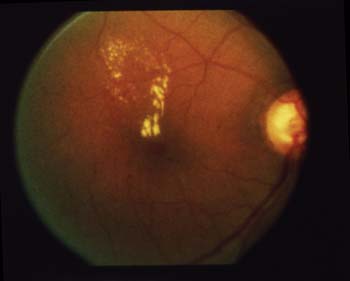Studies continue to find increasing levels of myopia in many countries, leading to growing concern about myopia-related complications. In Singapore, studies by Tien Yin Wong, MD, MPH, PhD, associate professor of ophthalmology at the University of Melbourne in Australia, determined that while 26 percent of conscripts in Singapore's Armed Forces had myopia in the 1970s, prevalence rose to 43 percent in the 1980s, 66 percent in the mid-90s, and hit 83 percent by the late 1990s. At the same time the number of soldiers with myopia worse than -8 D doubled from 2 to 4 percent. A similar trend was observed in Singapore's schoolchildren.
Leon B. Ellwein, PhD, associate director for applications of vision research at the National Eye Institute in Bethesda, Md., has overseen numerous studies conducted in China, Malaysia, Africa and India that evaluated myopia in thousands of children between the ages of 5 and 14. In Malaysia, myopia was present in 34 percent of 15-year-olds. A similar study in China found that myopia affected 73 percent of children 15 years of age. (In contrast, a study conducted in South Africa found a prevalence of just under 10 percent at the same age.)
Richard A. Stone, MD, Frayer Professor of Ophthalmology at the University of Pennsylvania and the Scheie Eye Institute, who has been involved with many myopia studies, believes the prevalence of myopia is also increasing in the United States, though he notes that this is controversial. "The statistic people usually quote for myopia in the United States is about 20 percent," he says, "but that data is about 30 years old. Recent population surveys have found rates around 40 percent in young adults." He also notes that a cross-sectional study of 1,585 offspring of participants in the Framingham Eye Study, reported in 1996, found that about 60 percent of subjects between the ages of 23 and 34 were myopic.

Although correcting the optics of the eye is not difficult, Dr. Stone says that an epidemic of myopia can become a public-health problem because potentially blinding conditions are associated with the anatomical distortions accompanying myopia—factors not addressed by refractive correction. "Two recent prevalence studies in Scandinavia and Taiwan found that between 10 and 15 percent of adult blindness is caused by retinal complications of myopia," he says. "An Australian study found that in higher ranges of myopia, the prevalence of retinopathy doubles with every 2-D increase. Likewise, detachments increase exponentially as myopia gets worse."
"One of the key issues we need to resolve is differentiating the consequences of high and low myopia," adds Dr. Wong. "Myopia greater than -6 D is associated with macular degeneration, macular holes, retinal breaks and retinal detachment. Whether lower myopia has health consequences is more controversial, but also more important, because low myopia affects the vast majority of the population in places like Singapore."
Drs. Stone and Wong both also note connections between myopia and glaucoma and cataracts. "A 1999 study found that the relative risk of glaucoma nearly doubles between an emetrope and a low myope, and goes up slightly for high degrees of myopia," says Dr. Stone. Studies by Dr. Wong found that after controlling for age, gender and baseline IOP, myopic individuals were 60-percent more likely to have glaucoma. He found a similar association between myopia and both nuclear and posterior subcapsular cataracts.
"Given the epidemic levels of low myopia," notes Dr. Wong, "even a small increase in the risk of poor health or complications being associated with it translates to a significant impact on society." Dr. Wong adds that myopia is often associated with diminished quality of life, and the costs for society of refractive correction by glasses or surgery can be significant.
Unfortunately, prevention of myopia remains problematic. "There are a lot of theories about what causes myopia, including that reading is to blame," notes Dr. Stone, "but studies showing a connection to reading often find only a small effect, and they're confounded by other parameters that may relate to myopia, such as socioeconomic status or family history. And if the cause is reading, is it focusing at near that's to blame, or some other factor such as the type of image the eye is seeing—black and white with small letters, instead of large, varied, colorful images? It's reasonable to assume that there's an association, but it's difficult to pin down exactly what that association might be."
Based on all the available evidence, Dr. Ellwein believes causality must be attributed to a combination of environment and genetics, but he says the genetic component is definitely not the dominant factor. "When we compare urban and rural children in China with the same genetics," he explains, "the rural children have low rates of myopia and the urban children have high rates."
Dr. Stone agrees. "Eskimos born before the Second World War had virtually no myopia," he says, "but 60 or 70 percent of Eskimos born after 1950 have myopia—one of the highest prevalence rates in the world."
Despite the mixed evidence about specific causes, Dr. Ellwein says that his studies have clearly shown that kids who were not in school hardly ever became myopic. "In Nepal at age 15, kids who were not in school had a prevalence rate of about 2 percent," he says. "The same was true in rural India."
So what can be done? "You can't tell kids to stop reading," observes Dr. Stone. He notes that some studies have tried giving kids progressive lenses or bifocals so that they won't have to accommodate when reading. "Most of those studies found either no effect or an effect that's so small that it's not clinically meaningful," he says. "At this point, it's not clear exactly what causes myopia, or what we can do about it."
Evizon with PDT Meets AMD Study Objective
Preliminary data from an exploratory, multicenter, randomized, double-masked, U.S. Phase II clinical trial (MSI-1256F-208) of Evizon (squalamine lactate, Genaera Corp.) shows that the study met its primary goal of demonstrating safety when dosed concomitantly with photodynamic therapy with Visudyne. Evizon with concomitant PDT was well-tolerated in all 45 subjects, with no drug-related serious adverse events reported to date. The most common adverse events involved infusion-site reactions. These events were generally mild and were distributed evenly across the Evizon plus PDT treatment groups.
Preliminary analyses showed that subjects treated with 40-mg Evizon plus PDT at 29 weeks had a slight increase in mean visual acuity compared to visual acuity at study entry, while the PDT-alone group demonstrated a decrease in mean visual acuity from baseline to 29 weeks. Approximately 90 percent of subjects maintained vision (defined as a gain or loss of less than 15 letters in visual acuity) when treated with 40 mg of Evizon plus PDT. Additionally, of the subjects treated with the combination of 40 mg of Evizon plus PDT, 10 percent required a second PDT treatment compared to 47 percent of those in the PDT-alone arm.
MSI-1256F-208 is a Phase-II trial designed to evaluate the safety and clinical effects of three different doses of Evizon (10 mg, 20 mg or 40 mg) along with initial concomitant PDT treatment in 10 subjects per group, or PDT-alone in 15 control subjects. The study also includes monthly Evizon maintenance therapy through six months, along with an additional 12 months of open-label treatment and follow-up for each patient.
Genaera is conducting a Phase-III and multiple Phase-II trials of Evizon in neovascular AMD at multiple investigational sites.
For information about participation in Evizon clinical trials, subjects and physicians may call Genaera's Clinical Trial Hotline at 1 (800) 299-9156.
Evizon is a unique first-in-class synthetic small molecule administered systemically that directly interrupts and reverses multiple facets of the angiogenic process. Working within activated endothelial cells, Evizon inhibits growth factor signaling including VEGF, and integrin expression, and reverses cytoskeletal formation, thereby resulting in endothelial cell inactivation and apoptosis. The drug may have a role in the treatment of human choroidal neovascular membrane formation that underlies the pathology of wet AMD, says the company.
Alimera, CDS Launch DME Trial
Alimera Sciences Inc., in collaboration with Control Delivery Systems Inc., has initiated a Phase- III clinical trial to study diabetic macular edema patients treated using Medidur with fluocinolone acetonide, the companies' pharmacologic treatment for DME.
The masked, randomized, multicenter study will follow 900 patients in the United States and Europe for 36 months. Patients will receive the Medidur implant, which is small enough to be injected through a needle during an in-office procedure and is expected to provide sustained delivery of fluocinolone acetonide to the back of the eye for up to three years. 
In February 2005, Alimera Sciences and CDS announced a worldwide agreement to co-develop and market Medidur using fluocinolone acetonide to treat DME. Alimera also has the option to develop three additional products using Medidur.
CDS also produced Vitrasert and Retisert, the only two sustained release systems approved by the FDA for the retina.
CMS Issues Ruling on Retisert
Bausch & Lomb announced that the Centers for Medicare & Medicaid Services has designated the single-indication orphan drug Retisert (fluocinolone acetonide intravitreal implant), 0.59 mg, as eligible for Medicare pass-through payment under the Hospital Outpatient Prospective Payment System (OPPS) effective October 1.
The payment rate to hospitals billing for Retisert using HCPCS code C9225 is set at $19,345, as reported in the October 2005 update of OPPS Addendum A on the CMS website, http://www.cms.hhs.gov/ providers/hopps. The payment methodology is based upon 106 percent of wholesale acquisition cost. Coding and payment amounts for non-Medicare procedures vary by insurer.
Retisert was approved as a single-indication orphan drug by the Food and Drug Administration in April for the treatment of chronic noninfectious uveitis affecting the posterior segment. B&L launched Retisert in the United States in June.



